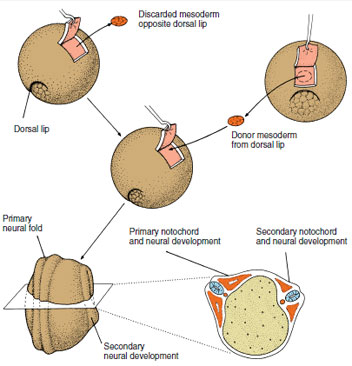Embryonic Induction
Embryonic Induction
Induction, the capacity of some cells
to evoke a specific developmental
response in others, is a widespread
phenomenon in development. The
classic experiments, were reported by
Hans Spemann and Hilde Mangold in
1924. When a piece of dorsal blastopore
lip from a salamander gastrula
was transplanted into a ventral or lateral
position of another salamander
gastrula, it invaginated and developed
a notochord and somites. It also
induced the host ectoderm to form a
neural tube. Eventually a whole system
of organs developed where the graft
was placed, and then grew into a
nearly complete secondary embryo
(Figure 8-15). This creature was composed
partly of grafted tissue and
partly of induced host tissue.
It was soon found that only grafts from the dorsal lip of the blastopore were capable of inducing the formation of a complete or nearly complete secondary embryo. This area corresponds to the presumptive areas of notochord, somites, and prechordal plate. It was also found that only ectoderm of the host would develop a nervous system in the graft and that the reactive ability was greatest at the early gastrula stage and declined as the recipient embryo got older.
Spemann designated the dorsal lip area the primary organizer because it was the only tissue capable of inducing the development of a secondary embryo in the host. He also termed this inductive event primary induction because he believed it to be the first inductive event in development. Subsequent studies showed that many other cell types originate by inductive interactions, a process called secondary induction.
Usually cells that have differentiated act as inductors for adjacent undifferentiated cells. Timing is important. Once a primary inductor sets in motion a specific developmental pattern in some cells, numerous secondary inductions follow. What emerges is a sequential pattern of development involving not only inductions but cell movement, changes in adhesive properties of cells, and cell proliferation. There is no “hardwired” master control panel directing development, but rather a sequence of local patterns in which one step in development is a subunit of another. In showing that each step in the developmental hierarchy is a necessary preliminary for the next, Hans Spemann’s induction experiments were among the most significant events in experimental embryology.
 |
| Figure 8-15 The Spemann-Mangold primary organizer experiment. |
It was soon found that only grafts from the dorsal lip of the blastopore were capable of inducing the formation of a complete or nearly complete secondary embryo. This area corresponds to the presumptive areas of notochord, somites, and prechordal plate. It was also found that only ectoderm of the host would develop a nervous system in the graft and that the reactive ability was greatest at the early gastrula stage and declined as the recipient embryo got older.
Spemann designated the dorsal lip area the primary organizer because it was the only tissue capable of inducing the development of a secondary embryo in the host. He also termed this inductive event primary induction because he believed it to be the first inductive event in development. Subsequent studies showed that many other cell types originate by inductive interactions, a process called secondary induction.
Usually cells that have differentiated act as inductors for adjacent undifferentiated cells. Timing is important. Once a primary inductor sets in motion a specific developmental pattern in some cells, numerous secondary inductions follow. What emerges is a sequential pattern of development involving not only inductions but cell movement, changes in adhesive properties of cells, and cell proliferation. There is no “hardwired” master control panel directing development, but rather a sequence of local patterns in which one step in development is a subunit of another. In showing that each step in the developmental hierarchy is a necessary preliminary for the next, Hans Spemann’s induction experiments were among the most significant events in experimental embryology.




